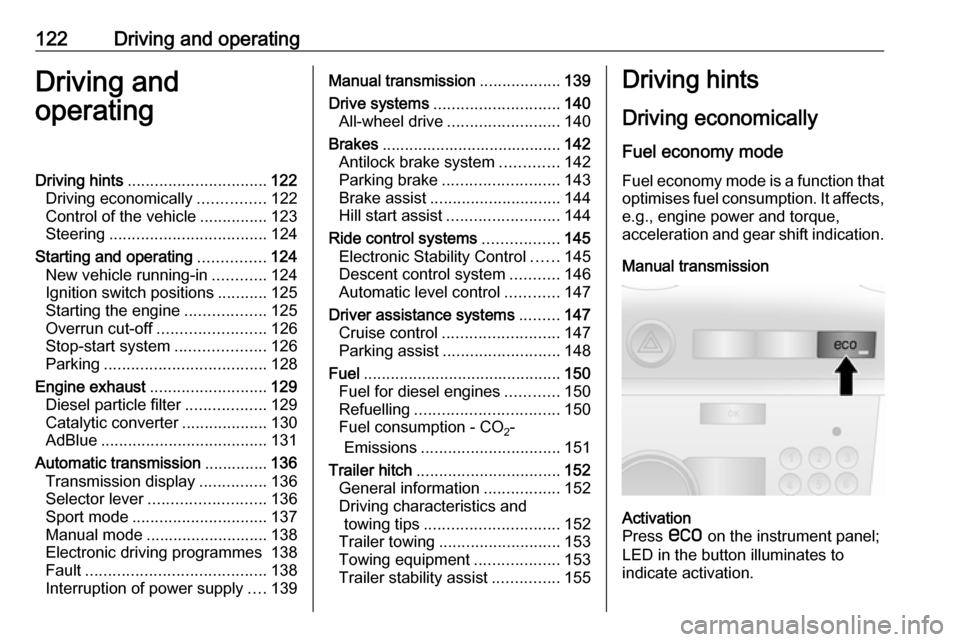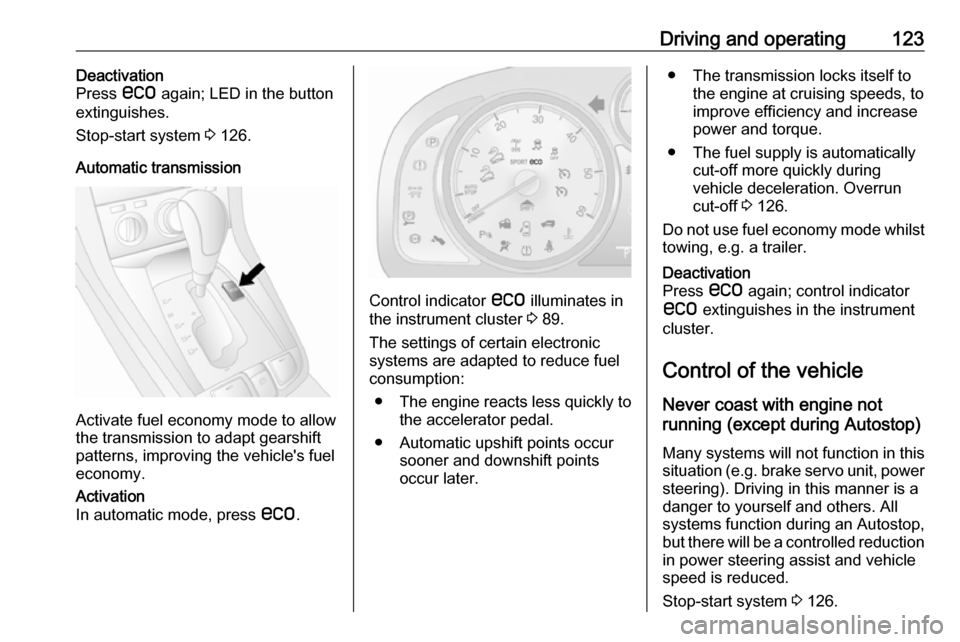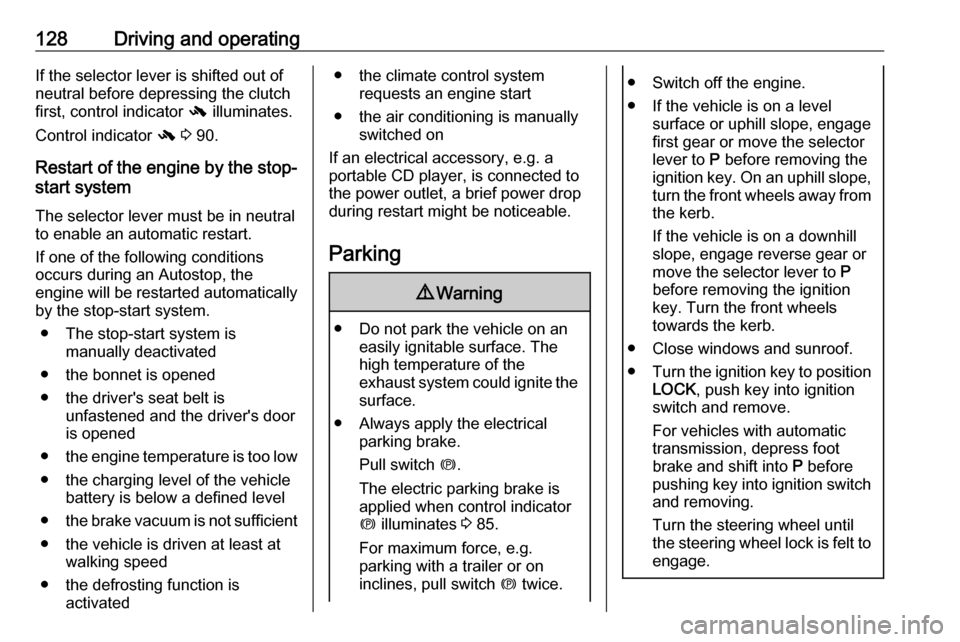tow OPEL ANTARA 2017.5 Manual user
[x] Cancel search | Manufacturer: OPEL, Model Year: 2017.5, Model line: ANTARA, Model: OPEL ANTARA 2017.5Pages: 225, PDF Size: 6.2 MB
Page 72 of 225

70StorageLoading information● Heavy objects in the load compartment should be evenlydistributed and placed as far
forward as possible. Ensure the
backrests are securely engaged.
If objects can be stacked, the
heavier objects should be placed
at the bottom.
With rear seats in the folded position, objects must not be stacked higher than the seat
backrests.
● Secure objects with lashing straps attached to lashing eyes
3 69.
● Secure loose objects in the load compartment, e.g. with a luggagefloor net, to prevent sliding.
● When transporting objects in the load compartment, the backrests
of the rear seats must not be
angled forward.
● Do not allow the load to protrude above the upper edge of the
backrests.● Do not place any objects on the load compartment cover or the
instrument panel, and do not cover the sensor on top of the
instrument panel.
● The load must not obstruct the operation of the pedals, electricalparking brake and gear selector,
or hinder the freedom of
movement of the driver. Do not
place any unsecured objects in
the interior.
● Do not drive with an open load compartment.9Warning
Always make sure that the load in
the vehicle is securely stowed.
Otherwise objects can be thrown
around inside the vehicle and
cause personal injury or damage
to the load or vehicle.
● The payload is the difference
between the permitted gross
vehicle weight (see identification
plate 3 205) and the EC kerb
weight.
To calculate the EC kerb weight,
enter the data for your vehicle in
the weights table at the front of
this manual.
The EC kerb weight includes
weights for the driver (68 kg),
luggage (7 kg) and all fluids (fuel
tank 90% full).
Optional equipment and
accessories increase the kerb
weight.
● Driving with a roof load increases
the sensitivity of the vehicle to
cross-winds and has a
detrimental effect on vehicle
handling due to the vehicle's
higher centre of gravity.
Distribute the load evenly and
secure it properly with retaining
straps. Adjust the tyre pressure
and vehicle speed according to
the load conditions. Check and
retighten the straps frequently.
Do not drive faster than
120 km/h.
The permissible roof load is
100 kg. The roof load is the
combined weight of the roof rack and the load.
Page 87 of 225

Instruments and controls85Have the cause of the fault eliminated
by a workshop.
Brake system
R illuminates red.
Illuminates when the ignition is
switched on and extinguishes shortly
after the engine starts. If it does not
illuminate, stop and seek the
assistance of a workshop.
Control indicator R illuminates if the
electrical parking brake is applied and
extinguishes when it is released
3 143.
If it stays lit while the engine is
running, the brakes do not operate as normal, or leaks are found in the
brake system, do not attempt to drive
the vehicle. Have the vehicle towed to a workshop for inspection and repair.9 Warning
Stop. Do not continue your
journey. Consult a workshop.
Illuminates when engine is running if
the fluid level for brake hydraulics is
too low 3 162.
Brake system 3 142.
Electrical parking brake
m illuminates or flashes red.
When the engine is started, m
illuminates briefly. If it does not
illuminate, seek the assistance of a
workshop.
Illuminates
Electrical parking brake is applied
3 143.
Flashes
Electrical parking brake is not fully
applied or released.
Switch on ignition, depress brake
pedal and attempt to reset the system by first releasing and then re-applying
the electrical parking brake.
If m remains flashing, do not drive
and seek the assistance of a
workshop.Electrical parking brake
fault
p illuminates yellow.
When the ignition is switched on, p
illuminates briefly. If it does not
illuminate, seek the assistance of a
workshop.
Illuminates
Electrical parking brake is operating
with degraded performance 3 143.9 Warning
Have the cause of the fault
remedied immediately by a
workshop.
Antilock brake system
(ABS)
u illuminates yellow.
Illuminates for a few seconds after the ignition is switched on. The system is
ready for operation when the control
indicator extinguishes.
Page 111 of 225

Lighting109Rear fog lights
Operated by pressing ø.
Control indicator ø 3 91 illuminates
in the instrument cluster when the rear fog light is switched on.
The rear fog light can only be
switched on when the ignition is on
and the light switch is in position 9,
or the front fog lights are on and the
light switch is in position 8.
Light switch in position AUTO:
switching on rear fog light will switch
on low beam and sidelights
automatically.
The vehicle rear fog light is
deactivated when towing.
Parking lights
When the vehicle is parked, the
parking lights on one side can be
activated:
1. Set light switch to 7 or AUTO .
2. Switch off ignition.
3. Move turn signal lever all the way up (right parking lights) or down
(left parking lights).
Confirmed by a signal tone and the
corresponding turn signal control
indicator.
To deactivate, switch on the ignition or move the turn signal lever in the
opposite direction.
Reversing lights
The reversing lights come on when
the ignition is on and reverse gear is
selected.
Centre high-mounted brake light Illuminates when the brakes are
applied, acting as a third stop light, to
supplement the brake lights.
Misted light covers
The inside of the light housing may
mist up briefly in poor, wet and cold weather conditions, in heavy rain or
after washing. The mist disappears
quickly by itself; to help switch on the
headlights.
Page 117 of 225

Climate control115Demisting and defrosting● Set the air distribution switch to l or J
● Set temperature control to warmest level
● Set fan to highest level
● Close centre air vents
● Open side air vents and direct them towards the door windows
Heated rear window Ü 3 32.
Air conditioning system
In addition to the heating and
ventilation system, the air
conditioning system has controls for:n:cooling4:air recirculationÜ:demisting and defrosting
Heated seats ß 3 40.
Cooling n
Press n
to switch on cooling.
Activation is indicated by illumination
of the LED in the button. Cooling is
only functional when the engine is
running and climate control fan is switched on.
Press n again to switch off cooling.
The air conditioning system cools and
dehumidifies (dries) as soon as the
outside temperature is slightly above
freezing point. Therefore
condensation may form and drip from under the vehicle.
If no cooling or drying is required,
switch the cooling system off to save
fuel.
Activated cooling may inhibit
autostops. Stop-start system 3 126.
Air recirculation system 4
Press 4 to activate air recirculation
mode. Activation is indicated by
illumination of the LED in the button.
Press 4 again to deactivate
recirculation mode.9 Warning
The exchange of fresh air is
reduced in air recirculation mode.
In operation without cooling the air humidity increases, so the
windows may mist up from inside.
The quality of the passenger
compartment air deteriorates,
which may cause the vehicle
occupants to feel drowsy.
In warm and very humid ambient air conditions, the windscreen might mist up from outside, when cold air is
Page 118 of 225

116Climate controldirected towards it. If windscreen
mists up from outside, activate
windscreen wiper and deactivate l.
Maximum cooling Briefly open the windows and sunroof
so that hot air can disperse quickly.
● Press n to activate air
conditioning.
● Press 4 to activate air
recirculation.
● Set air distribution switch to M.
● Set temperature control to coldest level.
● Set fan to highest level.
● Open all vents.Demisting and defrosting
● Set the air distribution switch to l or J.
● Set temperature control to warmest level.
● Set fan to highest level.
● Close centre air vents.
● Open side air vents and direct them towards the door windows.
● Switch on heated rear window Ü
3 32.
Air conditioning n and air
recirculation 4 are switched on
automatically to improve defrosting
efficiency when position l or J is
selected.
Activated demisting and defrosting
may inhibit autostops. Stop-start
system 3 126.
Electronic climate control system
The dual zone climate control allows
different climatisation temperatures
for driver and front passenger side.
In automatic mode, temperature, fan
speed and air distribution are
regulated automatically.
Page 124 of 225

122Driving and operatingDriving and
operatingDriving hints ............................... 122
Driving economically ...............122
Control of the vehicle ...............123
Steering ................................... 124
Starting and operating ...............124
New vehicle running-in ............124
Ignition switch positions ...........125
Starting the engine ..................125
Overrun cut-off ........................ 126
Stop-start system ....................126
Parking .................................... 128
Engine exhaust .......................... 129
Diesel particle filter ..................129
Catalytic converter ...................130
AdBlue ..................................... 131
Automatic transmission ..............136
Transmission display ...............136
Selector lever .......................... 136
Sport mode .............................. 137
Manual mode ........................... 138
Electronic driving programmes 138
Fault ........................................ 138
Interruption of power supply ....139Manual transmission ..................139
Drive systems ............................ 140
All-wheel drive ......................... 140
Brakes ........................................ 142
Antilock brake system .............142
Parking brake .......................... 143
Brake assist ............................. 144
Hill start assist ......................... 144
Ride control systems .................145
Electronic Stability Control ......145
Descent control system ...........146
Automatic level control ............147
Driver assistance systems .........147
Cruise control .......................... 147
Parking assist .......................... 148
Fuel ............................................ 150
Fuel for diesel engines ............150
Refuelling ................................ 150
Fuel consumption - CO 2-
Emissions ............................... 151
Trailer hitch ................................ 152
General information .................152
Driving characteristics and
towing tips .............................. 152
Trailer towing ........................... 153
Towing equipment ...................153
Trailer stability assist ...............155Driving hints
Driving economically Fuel economy mode
Fuel economy mode is a function that optimises fuel consumption. It affects,
e.g., engine power and torque,
acceleration and gear shift indication.
Manual transmissionActivation
Press s on the instrument panel;
LED in the button illuminates to
indicate activation.
Page 125 of 225

Driving and operating123Deactivation
Press s again; LED in the button
extinguishes.
Stop-start system 3 126.
Automatic transmission
Activate fuel economy mode to allow
the transmission to adapt gearshift
patterns, improving the vehicle's fuel
economy.
Activation
In automatic mode, press s.
Control indicator s illuminates in
the instrument cluster 3 89.
The settings of certain electronic
systems are adapted to reduce fuel
consumption:
● The engine reacts less quickly to
the accelerator pedal.
● Automatic upshift points occur sooner and downshift points
occur later.
● The transmission locks itself to the engine at cruising speeds, to
improve efficiency and increase
power and torque.
● The fuel supply is automatically cut-off more quickly during
vehicle deceleration. Overrun
cut-off 3 126.
Do not use fuel economy mode whilst towing, e.g. a trailer.Deactivation
Press s again; control indicator
s extinguishes in the instrument
cluster.
Control of the vehicle
Never coast with engine not
running (except during Autostop)
Many systems will not function in this
situation (e.g. brake servo unit, power steering). Driving in this manner is a
danger to yourself and others. All
systems function during an Autostop,
but there will be a controlled reduction
in power steering assist and vehicle
speed is reduced.
Stop-start system 3 126.
Page 130 of 225

128Driving and operatingIf the selector lever is shifted out of
neutral before depressing the clutch
first, control indicator - illuminates.
Control indicator - 3 90.
Restart of the engine by the stop- start system
The selector lever must be in neutral to enable an automatic restart.
If one of the following conditions occurs during an Autostop, the
engine will be restarted automatically
by the stop-start system.
● The stop-start system is manually deactivated
● the bonnet is opened
● the driver's seat belt is unfastened and the driver's door
is opened
● the engine temperature is too low
● the charging level of the vehicle battery is below a defined level
● the brake vacuum is not sufficient
● the vehicle is driven at least at walking speed
● the defrosting function is activated● the climate control systemrequests an engine start
● the air conditioning is manually switched on
If an electrical accessory, e.g. a
portable CD player, is connected to
the power outlet, a brief power drop
during restart might be noticeable.
Parking9 Warning
● Do not park the vehicle on an
easily ignitable surface. The
high temperature of the
exhaust system could ignite the
surface.
● Always apply the electrical parking brake.
Pull switch m.
The electric parking brake is
applied when control indicator
m illuminates 3 85.
For maximum force, e.g.
parking with a trailer or on
inclines, pull switch m twice.
● Switch off the engine.
● If the vehicle is on a level surface or uphill slope, engage
first gear or move the selector
lever to P before removing the
ignition key. On an uphill slope, turn the front wheels away from
the kerb.
If the vehicle is on a downhill
slope, engage reverse gear or
move the selector lever to P
before removing the ignition
key. Turn the front wheels
towards the kerb.
● Close windows and sunroof.
● Turn the ignition key to position
LOCK , push key into ignition
switch and remove.
For vehicles with automatic
transmission, depress foot
brake and shift into P before
pushing key into ignition switch and removing.
Turn the steering wheel until
the steering wheel lock is felt to
engage.
Page 132 of 225

130Driving and operatingIf cleaning of the filter is required andprevious driving conditions did not
enable automatic cleaning, it will be
indicated by control indicator %
3 88.
% illuminates, accompanied by a
warning chime, when diesel particle
filter is full. Start cleaning process as
soon as possible.
% flashes when diesel particle filter
has reached the maximum filling level. Start cleaning process
immediately to avoid damage to the
engine. A warning chime sounds
every 3 minutes until the cleaning
process is complete.
Cleaning process To activate the cleaning process,
continue driving, keeping engine
speed above 2000 revolutions per
minute. Shift down if necessary.
Diesel particle filter cleaning is then
started.
If control indicator Z illuminates
additionally in the instrument cluster
when the engine is running, there
may be a fault in the diesel particlefilter 3 84. Cleaning is not possible,
seek the assistance of a workshop
immediately.Caution
If the cleaning process is
interrupted, there is a risk of
provoking severe engine damage.
Cleaning takes place quickest at high engine speeds and loads.
Do not switch off the engine until the
cleaning process is complete. This is
indicated by the extinguished control
indicator %.
Catalytic converter
The catalytic converter reduces the
amount of harmful substances in the
exhaust gases.
Caution
Fuel grades other than those listed 3 207 could damage the catalytic
converter or electronic
components.
Unburnt fuel will overheat and
damage the catalytic converter.
Therefore avoid excessive use of the starter, running the fuel tank
dry and starting the engine by
pushing or towing.
In the event of misfiring, uneven
engine running, a reduction in engine performance or other unusual
problems, have the cause of the fault
rectified by a workshop as soon as
possible. In an emergency, driving
can be continued for a short period,
keeping vehicle speed and engine
speed low.
Malfunction indicator light 3 84.
Page 133 of 225

Driving and operating131AdBlue
General information
The selective catalytic reduction
(BlueInjection) is a method to
substantially reduce the nitrogen
oxides in the exhaust emission. This
is achieved by injecting a Diesel
Exhaust Fluid (DEF) into the exhaust
system.
The designation of this fluid is AdBlue Ⓡ. It is a non-toxic, non-flammable,
colourless and odourless fluid which
consists of 32% urea and 68% water.
Note
AdBlue Ⓡ is a registered trademark
of the Verband der
Automobilindustrie e.V. (VDA).9 Warning
Avoid contact of your eyes or skin
with AdBlue.
In case of eye or skin contact,
rinse off with water.
Caution
Avoid contact of the paintwork with AdBlue.
In case of contact, rinse off with water.
AdBlue freezes at a temperature of
approx. -11 °C. As the vehicle is
equipped with an AdBlue pre-heater,
the emissions reduction at low
temperatures is ensured. The AdBlue
pre-heater works automatically.
The typical AdBlue consumption is
approx. two litres per 1000 km, but
can also be higher depending on
driving behaviour (e.g. high load or
towing).
Level warnings
If the AdBlue level falls below a
certain value, a level warning (e.g.
"AdBlue Range: 2400 km") will be
shown in the Driver Information
Centre 3 91, located in the centre of
the instrument cluster.
Refill the tank with a volume of at least
10 litres of AdBlue as soon as
possible. Refer to " Refilling AdBlue"
below.
Driving is possible without any
restrictions.